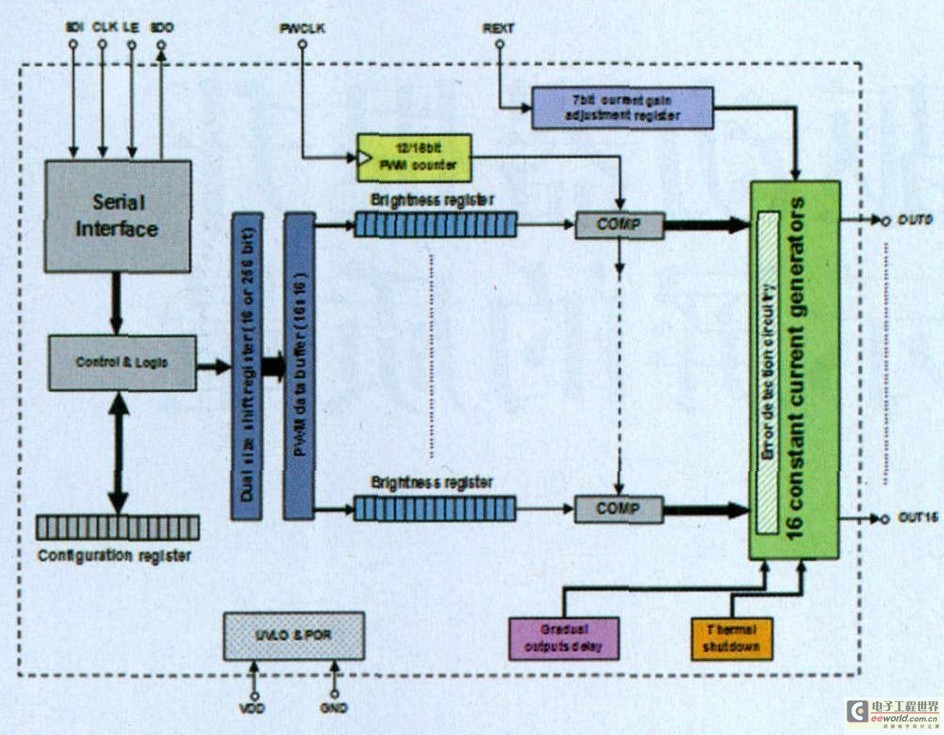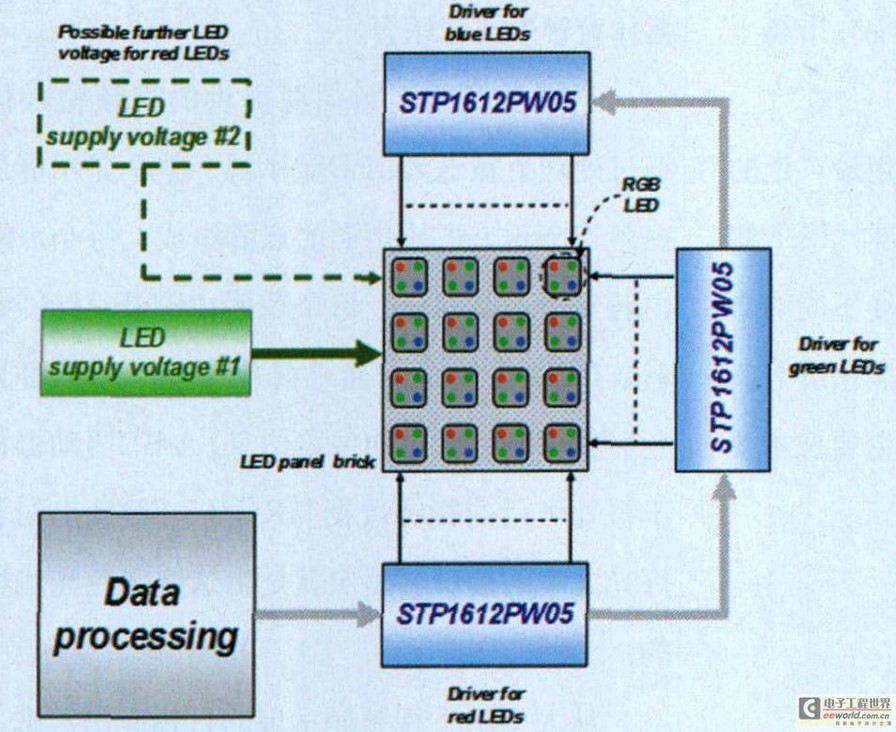LED LEDs that we see everywhere in our daily lives are no longer a new technology. The strong growth of LEDs in multiple market segments is a fact.
Advertising displays or digital signage are among the most widely used areas of LED applications. From monochrome displays to full-color displays, LED solutions are widely used for signposts, advertising displays, indoor and outdoor video displays, etc. with different market needs and complexity. This article focuses on the main technical requirements of a full-color LED video display and how to achieve the required performance.
Full color LED video display
The full-color LED video display is a display that displays images and animations in millions of colors. LED display applications include stadiums, building exteriors, shopping centers, and television studios. Large LED displays are used to play advertisements and information, replay sports events or concerts.

Figure 1 is a schematic diagram of the LED display structure
The video input signals provided by different types of video sources are processed and sent to the LED display. The entire display usually consists of a number of square or rectangular lattices, each consisting of several pixels. Each pixel consists of RGB (red, green, blue) LED tubes that mix the color of the LEDs to produce the desired pixel information. The LED driver is the interface between the processed video data and the colored lights emitted by the RGB LEDs (the image is made up of these colored lights).
From the target application of large LED video display, we can easily realize the important role played by image quality. This concept contains several aspects:
The signal quality of the original image and the data processing capability are prerequisites for good image quality.
The size of the display, the resolution, pixel pitch and LED selection are key parameters that determine the quality of the human eye.
You need to choose a suitable LED driver that converts the processed image data into the desired color and animation effects.
Since the purpose of this article is to describe the LED driver solution for LED displays, we will focus on the last point of the three aspects mentioned above in the following sections.
LED display requirements for LED drivers
In terms of color and animation, in order to achieve excellent image quality, it is necessary to integrate a variety of different functions: high frame rate, high refresh rate, color reproduction accuracy, and the like. However, the quality of the display refers not only to the image itself, but also to the overall quality of the solution, such as immunity to interference and reliability. Therefore, all color LED displays require the selection of sophisticated LED drivers:
Good color rendering depends on the effective brightness of each RGB (and each color): the higher the effective brightness, the richer the displayed color. Proper and fine control of brightness requires the use of PWM dimming technology to control a large amount of brightness.
High frame rates and high refresh rates require large amounts of data to be processed at high rates. LED drivers meet these requirements with high-frequency serial ports and flexible data format management capabilities.
The failure of one or more LED tubes affects the accuracy of the pixel color, jeopardizing the overall visual effect of the image and affecting the quality of the system. Keeping the display visually pleasing requires a reliable LED failure condition detection method.
Full color video display LED driver solution
STMicroelectronics has a wide range of display and digital signage LED driver products, of which STP1612PW05 (see Figure 2) is ST's LED driver specifically developed for full-color LED video displays. This product is a 16-channel LED driver with a built-in high frequency serial data interface. The maximum output current of each channel is 60mA, the output current can be adjusted by an external resistor, and an 8-bit gain register can be used to accurately adjust 256 levels of gray.
Improving current accuracy at lower currents (±1.5% typical between channels) meets the LED efficiency improvement requirements of LED technology. In fact, the advent of energy-efficient LEDs has allowed display manufacturers to achieve the same brightness with lower current LED drivers. The product is equipped with independent adjustable PWM brightness control for each output channel. The well-known PWM dimming function has advantages in LED color protection and adjustable brightness of 4096 (12-bit) or 65536 (16-bit) level, which can significantly improve the color difference and image quality.
In addition, to further enhance the dimming control function, the product also uses the Scrambled PWM mode. The PWM total period basically covers a lot of refresh cycles, and the effect is to keep the dimming resolution constant while maintaining the dimming frequency, thereby reducing the flicker of the picture.
STP1612PW05 built-in serial interface meets the display's high-speed data rate and data format flexibility requirements: data transmission clock frequency can be up to 30MHz, using 16x16-bit format (if the brightness is 4096, the data format is 6x12) or higher compression 256-bit format. As mentioned earlier, an anti-interference and reliable LED driver can greatly improve the overall quality of the system.
When a failed LED tube (open or short) is found, the STP1612PW05 sends the test result to the microcontroller via the serial interface, thereby avoiding color change or shutdown of the relevant pixels and protecting the image consistency.

Figure 2 Schematic diagram of STP1612PW05
At the beginning of a video image, all the LED tubes are turned on at the same time, which will generate a surge with a large rising slope, which means that a large input capacitance is required, the parasitic channel will oscillate, and the system generates noise. Make four consecutive outputs into one group (1st group OUT0, OUT1, OUT2, and OUT3; Group 2 from OUT4 to OUT7; arranged in this order), with a continuous delay of 40ns between each group, making the output channel conductive Time is staggered, which can greatly reduce the inrush current. For any reason (line disconnection), the PWCLK clock signal does not exist (PWM counter clock signal for PWM dimming control), which causes all LEDs on the display to turn on indefinitely.
In addition to affecting the correct display of the image, this accident can also burn or damage the LED tube. The STP1612PW05 has a built-in protection function that activates the PWM clock timeout. When the PWCLK signal disappears for more than 1 second, the signal generator is forcibly turned off.
Application example
The LED forward voltage and the configurable current that achieve the target brightness vary with the color of the LED: among the three color LEDs of red, green and blue, the red LED has the lowest forward voltage and the blue LED has the lowest driving current. . Therefore, it is recommended to use a different drive for each light color.

Figure 3 depicts an application example implemented with STP1612PW05
Each display dot matrix is ​​composed of 16 pixels, each pixel consisting of 4 color LED tubes (1 red, 1 blue, 2 green). Sixteen LEDs of the same color are driven by an STP1612PW05. The choice of LED supply voltage (VLED) is a balanced consideration between several often opposing requirements. The VLED voltage should be high enough to keep the LEDs in the correct state, but the voltage drop of the LED driver's current generator should be minimized, which can cause unwanted power consumption and cause the chip and system to overheat.
Obviously, sharing a VLED voltage for red, green and blue light is not the best solution. The ideal solution is to optimize the LED supply voltage and separate the voltage rails of the LED tubes to achieve the desired results.
This requires a reasonable driving of all LED tubes while saving power.
in conclusion
The high quality requirements of full color LED video displays give designers the challenge of choosing the right LED driver to choose from. Superior color reproduction performance and minimized video distortion are essential requirements for these applications. STMicroelectronics' custom LED drivers for full-color video displays are a high-quality solution that meets the technical requirements of full-color video displays.
Product application:
â– Products for commercial,household,lighting
Product features:
â– Good heat dissipation
--Blade design of copper alloy contacts,good conductivity
â– Super high impact resistance and thermal stability
--Cover pans are made of high quality polycarbonate
â– Chemical corrosion resistance
-- Corrosion resistant galvanized mounting bracket
â– Grounding.Connection mode
--One-piece grounding design
---Clip in type wiring,spring sheet lock,suitable for #14AWG
hard copper wire
Duplex Receptacle TR UL,White Duplex Receptacle TR UL,Electrical Duplex Receptacle TR UL,Wall Duplex Receptacle TR UL
Hoojet Electric Appliance Co.,Ltd , https://www.hoojetgfci.com
